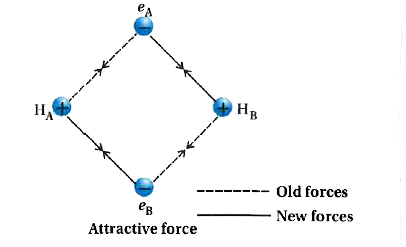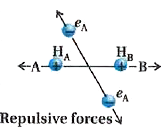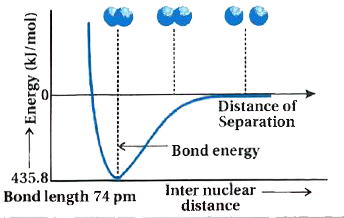Explain the formation of H2 molecule on the basis of valence bond Theory.
Consider two hydrogen atoms A and B approaching each other having nuclei NAandNB and electrons present in them are represented by eAandeB .
When the two atoms are at large distance from each other, there is no interaction between them. At this time the energy of system is equal to energy of both H atom in th.is stage in each atom • nucleus and electron has attraction with such other NA−eAandNB−eB.
When both atoms HAandHB come near to each other: When two atom HAandHB come near to each other the attractive and repulsive forces are produced between them.
(i) Attractive forces : The attractive forces produced between nucleus of the atom itself and its own electron or NA−eANB−eB . The attractive force produced between nucleus of the one atom and electron of other atom NA−eBandNB−eA

(ii) Repulsive forces :
Repulsive force produced between electron-electron or two atoms eA−eB .
Repulsive force produced between nucleus of two atom NA−NB .

Attractive forces try to take both the atom near to each other while repulsive force try to push each other.
It is proved from the experiments that the magnitude of attractive forces is more than that of repulsive forces. As a result both the atoms go near to each other and their potential energy decreases.
H2 formation : (i) Both the atoms go near to each other to such an extent that attractive forces are balanced by repulsive forces and (ii) system attain minimum energy. (iii) At this stage both hydrogen atoms combine with each other. (iv) Stable hydrogen molecule is form (v) Bond length is 74 pm.
Energy change : (i) When both hydrogen are away form each other their energy is taken zero. (ii) As they come near energy decrease (iii) At definite distance (bond length) when forces are balanced and bond form 435.8 kg/mol energy molecule. It is minimum energy (iv) If both atom are more closer than this than energy increase + bond break.
H2(g)+435.8kgmol−1=H(g)+H(g)
Here the given energy is bond enthalpy of H2. the energy change is given in following diagram.

Supplementary Question : Explain energy change in H2 molecule.
Supplementary Question : Bond length of H2 and at this length what is between two H ?
Supplementary Question : When two H come near to each other which attraction and repulsive force observed?
Supplementary Question : When the bond form between two H atom ?
Topper's Solved these Questions
- CHEMICAL BONDING AND MOLECULAR STRUCTUREBOOK - KUMAR PRAKASHANCHAPTER - CHEMICAL BONDING AND MOLECULAR STRUCTUREEXERCISE - TRY YOUR SELF-3
1 Videos
- CHEMICAL BONDING AND MOLECULAR STRUCTUREBOOK - KUMAR PRAKASHANCHAPTER - CHEMICAL BONDING AND MOLECULAR STRUCTUREEXERCISE - TRY YOUR SELF-4
1 Videos
- CLASSIFICATION OF ELEMENTS AND PERIODICITY IN PROPERTIES BOOK - KUMAR PRAKASHANCHAPTER - CLASSIFICATION OF ELEMENTS AND PERIODICITY IN PROPERTIES EXERCISE - Section -D SOLUTIONS OF NCERT EXEMPLAR PROBLEMS (Long Answer Type Questions )
7 Videos
Similar Questions
Explain the formation of H2 molecule on the basis of valance bond theory.
View SolutionExplain the formation of H2 molecule on the basis of valance bond theory.
View SolutionDiscuss the formation of H2 molecule on the basis of Valence-bond theory.
View SolutionDescribe the formation of H2O molecule on the basis of valence bond theory.
View SolutionDescribe the formation of HF and NH3 molecules on the basis of valence bond theory.
View SolutionDescribe the salient features of valence bond theory. Explain the formation of H2 molecule on the basis of this theory.
View SolutionFormation OF Molecules on the Basis OF Valence Bond Theory (VBT)
View SolutionExplain the structure of [Ni(CN)4]2− on the basis of valence bond theory.
View SolutionExplain the diamagnetic behavior of F2 molecule on the basis of molecular orbital theory.
View SolutionExplain the diamagnetic behaviour of F2 molecule on the basis of molecular orbital theory.
View Solution
